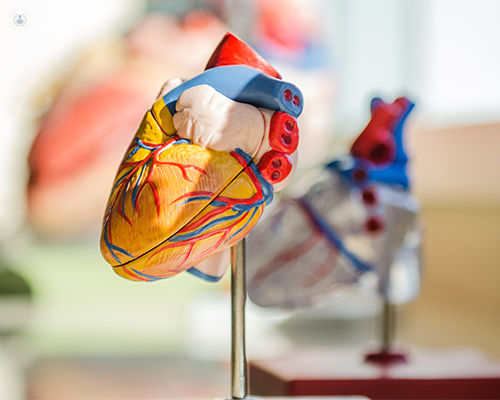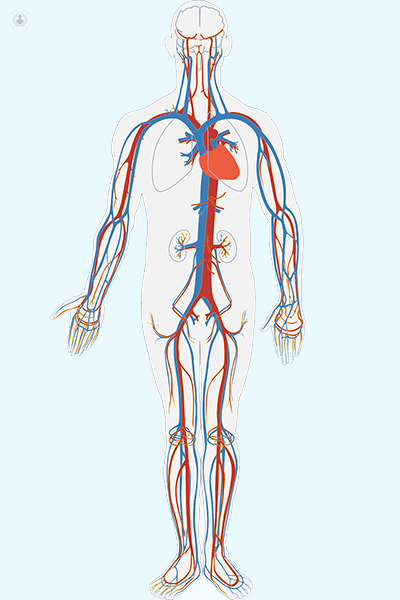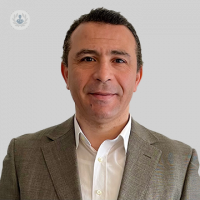Abdominal aortic aneurysms monitoring and treatment
Escrito por:An abdominal aortic aneurysm (AAA) can be fatal if it bursts. This is why monitoring an aneurysm until it’s a certain size and elective surgical treatment are critically important when an AAA is diagnosed. We (vascular surgeons), can provide regular scans, suggested lifestyle adjustments and surgical procedures to lower your risk of a burst AAA.

What is the aorta?
The aorta is the main blood vessel from the heart. Blood vessels are like pipes, and these deliver blood to different organs in the body.

- The aorta starts from the heart.
- Then it runs into the chest (the thoracic aorta).
- The aorta then runs into the tummy (abdomen).
- Then the aorta divides into two branches at the level of the belly button (the abdominal aorta).
What is an aneurysm?
An aneurysm is a localised swelling of an artery. The abdominal aorta is 1.5 cm to 2.4 cm in diameter, but if it swells to 3 cm diameter or more, it’s considered an aneurysm.
Aneurysms that happen due to atherosclerosis (the hardening of the artery wall) develop slowly over many years. However, aneurysms due to infection (mycotic aneurysm) or inflammation (vasculitis aneurysm) may develop rapidly and increase in size at a fast pace.
How common are abdominal aortic aneurysms?
Aneurysms can affect any artery but the aorta is the most commonly affected blood vessel. In fact, 95 per cent of aortic aneurysms affect the segment of the aorta in the abdomen. Also, abdominal aortic aneurysm (AAA) is more common in male patients than in females with a ratio of almost 9:1.
How does the size of an AAA affect treatment?
The treatment cutoff size
The cutoff size to treat an abdominal aortic aneurysm (AAA) is 5.5 cm in diameter in male patients, and 5 cm in female patients. This threshold has been determined according to several studies that looked at surgical treatment of AAA versus surveillance, such as the UK Small Aneurysm Trial of the Multicentre Aneurysm Screening Study (MASS), among other trials. At this size, the risk of a rupture of the aneurysm outweighs the risk of death from the surgical intervention.
Calls to reduce the threshold
However, this size was agreed when open surgical repair of the AAA was the main treatment option. Now, endovascular aneurysm repair (EVAR) is the main treatment strategy in many vascular centres across the world. EVAR poses a much lower risk of death compared to open surgery. This has caused lots of calls to reduce the size threshold for treating AAA across the world. Nevertheless, 5.5 cm for males and 5 cm for females is still the threshold of treating AAA in the UK and many other countries.
What are the signs of a burst abdominal aortic aneurysm?
Someone with a burst AAA might pass out for a few seconds or minutes and/or feel very weak and cold. There might be a large pulsating mass in the tummy if the patient is very slim.
Sudden onset of severe pain in the tummy, flanks, lower back or the groin in any male patient above the age of 60 should be considered as caused by a ruptured aneurysm until proven otherwise.
What happens if an aneurysm has burst?
Unfortunately, a burst aneurysm is fatal in more than 70 per cent of cases. It is estimated that 50 per cent of cases of ruptured aneurysm do not make it to the hospital and they pass away at home. Sadly, 50 per cent of patients who reach the hospital cannot survive the burst either before or after treatment. For this high risk of dying from a burst aneurysm, it is essential that whenever the aneurysm reaches the threshold (5.5 cm for men and 5cm for women), it should be considered for elective treatment.
How are small and medium AAA's monitored?
Small and medium-size AAAs are put into a surveillance program to keep an eye on the progress of the size.
3.5 to 4.5 cm
If an AAA is 3 to 4.5 cm, it will require a yearly ultrasound scan to check the increase in the size of the aneurysm.
4.5 to 5 cm and above
Between 4.5 and 5 cm, an ultrasound scan should be repeated every 6 months. Above 5 cm, the scan should be repeated every three months until it reaches 5.5 cm.
How to treat small and medium AAAs
Unfortunately, there are no non-surgical medical treatments to cure abdominal aortic aneurysms. However, there are things to do to improve your health and slow the increase in the size of an AAA:
1. Stop smoking
Stopping smoking is the single most important thing to do if you are a smoker. Smoking can cause the arteries to narrow or block and, at the same time, it causes the blood to be stickier than normal. This can cause blood to clot more quickly, which increases the risk of an aneurysm.
2. Control your diet
Hypertension (high blood pressure) is a risk factor for AAA. Cutting down on the amount of salt in the diet helps to reduce blood pressure. Also, reducing cholesterol and saturated fats in your diet is very important for lowering your AAA risk, and maintaining a healthy weight can improve your general health.
3. Control risk factors
If you have diabetes or blood pressure problems, make sure they are under tight control. Taking cholesterol-lowering tablets (statins) is very important. Statins have been found to reduce the increase in the size of AAA. Aspirin or Clopidogrel (blood thinners) could also be prescribed by your GP to make your blood slightly thinner.
How to treat large AAAs
Once the size of your AAA is 5.5 cm, you will need a CT scan with an injection of contrast in the veins of the arm. This will inform us of the exact size of the aneurysm in addition to the anatomy and shape of the aneurysm.
Further tests are required to assess the fitness for the operation like a scan of the heart, assessment of the lung functions, blood tests, chest X-ray and an electrocardiogram (ECG). In general terms, there are two ways to treat a large abdominal aortic aneurysm: open surgical repair and endovascular aneurysm repair (EVAR).
Open surgical repair
Open surgery involves making a large cut in your tummy and replacing the aneurysm-affected part of the abdominal aorta with a synthetic graft. The graft used could be either a straight tube graft or a bifurcated graft (like a trouser).
The graft will be sewn to a normal segment of the aorta at the top and the bottom of that segment. The operation is done under general anaesthetic and usually takes 2-3 hours. The patient usually requires a stay in the intensive care unit for a day or two and has a total hospital stay of 7 days on average. This is a major surgery with a risk of death in the range of 3-5 per cent and a full recovery usually takes 3-6 months.
Endovascular aneurysm repair (EVAR)
Endovascular aneurysm repair (EVAR) is a minimally invasive procedure. It is done through a 1-2 cm cut in each groin and involves inserting a stent graft inside the aneurysm. The graft will be fixed in place with metal hooks that anchor to the healthy part of the aorta.
The operation could be done under general, spinal or even local anaesthetic and usually takes 1-2 hours. The hospital stay is 2 days on average. The risk of dying from the operation is less than 1% and recovery usually takes 1-2 weeks.
Mr Mohamed Abdelhamid has over 20 years’ experience treating vascular conditions like AAA. See his Top Doctors profile to discover how he can help you.


